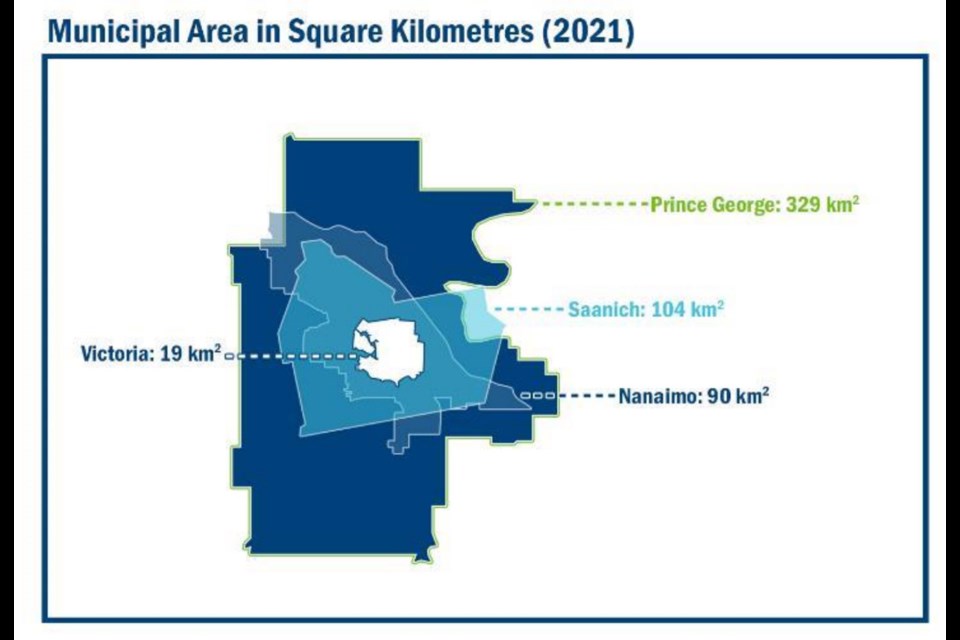Given the challenges facing the City of Prince George, the city’s taxes should be higher than they are, according to two of the city’s senior administrators.
During a budget presentation to city council on Monday night, city manager Walter Babicz and city director of finance Kris Dalio said that given the unique challenges facing the city, Prince George’s taxes should be higher than other comparable B.C. municipalities.
“It’s not surprising we have high per-capita tax rates,” Babicz said. “We have a big city with a low population. Our reality is we need to grow our population to meet our infrastructure needs.”
A Citizen examination of the 20 largest municipalities in B.C found that Prince George had the second-highest per capita tax rate among B.C.’s big cities. However, the total taxes and fees (municipal, regional district and other agency property taxes, plus garbage and utility fees) for an average single-family house in Prince George were the third-lowest in the group, after Kamloops and Chilliwack.
A decision in 1975 to increase the city limits from 61 sq. kilometres to 329 sq. km was made based on the rapid population growth seen in the city from the 1950s to the 1970s, Babicz said.
“Prince George was a boom town in the 1970s, and then it wasn’t,” he said. “The physical size of our city was supposed to have more than 200,000 (people) by now.”
The city’s first official community plan, created in 1979, projected Prince George would have a population of 185,000 people by 2012. However, population growth in the city stalled in the 1980s and the city’s population has stayed relatively unchanged since the mid-1990s.
As a result, the city has more roads, water mains and sewer pipes and other infrastructure - much of it built in the 1960s, ‘70’s and 80’s - than other B.C. cities of comparable populations, Babicz said. Prince George is more than 35 per cent larger in area than Kamloops and Kelowna, with 20,000 to 70,000 fewer residents.
Prince George is larger than the District of Saanich (104 sq. km), City of Naniamo (90 sq. km) and City of Victoria (19 sq. km) combined, with a population 17 to 35 per cent smaller than any of them.
“The average age of our infrastructure is 45 years old,” Babicz said. “Our infrastructure is old, and it has to serve a very large area.”
Prince George spends allocates $10 million per year to snow control, Dalio added. far more than comparable municipalities in the Lower Mainland and Vancouver Island need to spend.
“We do have some pressures that other municipalities don’t,” Dalio said.
SAFE RESTART MONEY AN OPTION
In 2021 and 2021, city council made the choice to defer tax increases by using money from the $6.11 million COVID-19 Safe Restart Grant the city received from the provincial and federal governments, Dalio said.
“It should have been 3.5 per cent (tax increase) each year,” Dalio said. “Instead we had zero per cent and three per cent.”
The remaining $2.86 million of grant funding could be used to defer 2023’s property tax increase by roughly 2.4 per cent, on a one-time basis. However, several members of council showed little interest in using the last of the grant for that purpose.
“To continue to defer taxes with the Safe Restart fund isn’t going to help anybody… it is just going to kick this can down the road,” Coun. Kyle Sampson said.
At Dalio’s suggestion, Sampson said he’d like to see the Safe Restart money allocated towards covering the estimated $5.5. million in retroactive pay for the RCMP, which was part of the contract negotiated by the federal government. Using the grant to that, would allow the money the city has already set aside for that purpose to be used elsewhere.
Sampson also proposed funding a proposed feasibility study for a fire training centre in the city, at a cost of $100,000, from the grant money.
‘WE ARE NOT DOING EVERYTHING WE SHOULD BE DOING’
The city’s capital spending on infrastructure maintenance is not keeping up with the needs, Dalio said.
“We’re not doing everything we should be doing. That infrastructure gap is continuing to grow,” he said. “Eventually, this causes problems for us.”
The sinkhole which closed a section of Winnipeg Street for months in 2018 was a direct result of lack of investment in the city’s storm water infrastructure, he said.
Starting in 2024, the city has identified millions of dollars of essential maintenance projects - $9.4 million in 2024, $7 million in 2025, $6.1 million in 2026 and $6.2 million in 2027 – for which the city has no funding source, Dalio said. The unfunded projects include things like repairs to stormwater drains, sidewalks, trails, parking lots, playgrounds, ball diamonds and more.
“These are areas we think are really important to maintain our assets,” Dalio said. “If we don’t have a funding source, we’ll have to use debt to fund them.”
The alternative is to increase the levy, and thus taxes on residents, to avoid going into debt to do routine annual maintenance projects, he said.
Prince George city council will continue its budget deliberations on Wednesday, when they will consider a budget with a proposed tax increase between 7.23 and 8.17 per cent.
“This is an ‘essentials only’ budget this year,” Babicz said.



